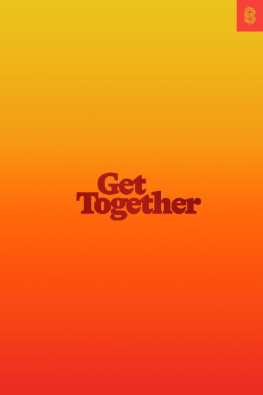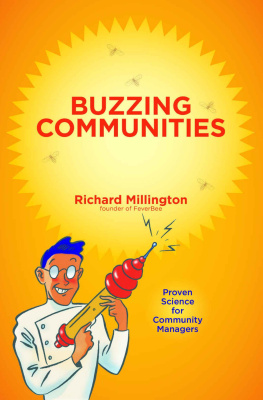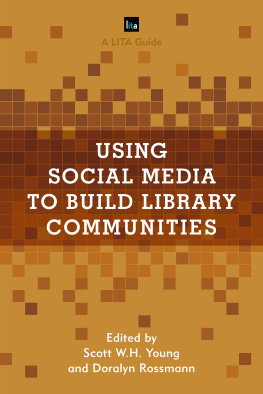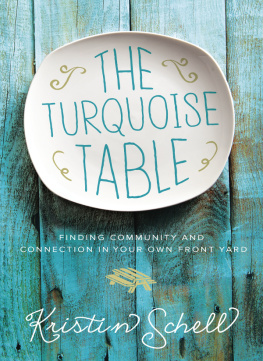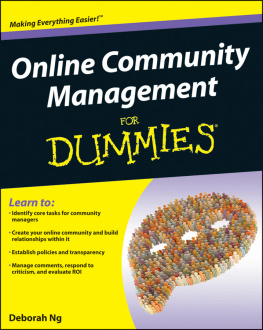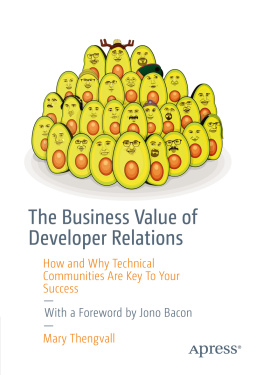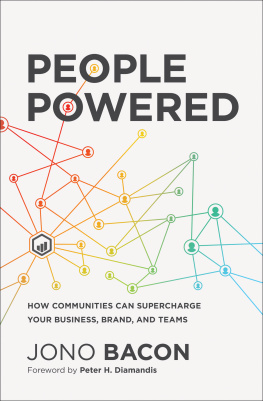
Summary
Although communities feel magical, they dont come together by magic. Get Together is a guide to cultivating a communitypeople who come together over what they care about. Whether youre starting a run crew, helping online streamers connect with fans, or sparking a movement of K-12 teachers, the secret to getting people together is this: build your community with people, not for them. In Get Together , the People & Company team provides stories, prompts, and principles for each stage of cultivating a passionate group of people. Every organization holds the potential to build and sustain a thriving community. Get Together shows readers how companies and customers, artists and fans, or organizers and advocates can join forces to accomplish more together than they could have alone.
About the Authors
Bailey Richardson, Kevin Huynh, and Kai Elmer Sotto comprise People & Company, an agency that helps organizations build communities. Theyve helped create and support communities of investors, entrepreneurs, teachers, caregivers, dog walkers, runners, surfers, and more. Bailey brings her expertise as a storyteller and researcher. She helped shape the communities around Instagram, ideo, and Pop-Up Magazine. Kevin breathes strategy and structure. He advises groups that build empowered communities, and in the past he operationalized CreativeMornings, rolling out events in 100 cities. Kai focuses on how true communities fuel growth for companies. He helped pioneer Facebooks growth discipline and launch Instagrams business internationally.
Courage
"One of the greatest gifts anybody can give is the inspiration to develop courage. If people feel comfortable enough to develop some courage, then they can do anything they really want to dowhy, they can devise their own lives.
Maya Angelou
Author, poet, and activist
For our families, who developed our courage: Lainey, Bruce, Perry, Sheila, Chris, Jeff, Yoko, Robert, Diana, Laarnie, Bella, and Kaila.
Bailey, Kevin, and Kai
Get Together
How to build a community with your people
2019 People & Company
All rights reserved. No part of this publication may be reproduced or transmitted in any form or by any means, electronic or mechanical, including photocopying, recording, or any other information storage and retrieval system, without prior permission in writing from the publisher.
First published in 2019 in hardcover
in the United States of America
by Stripe Press/Stripe Matter Inc.
Stripe Press
Ideas for progress
San Francisco, California
press.stripe.com
Printed in Canada
ISBN: 978-1-7322651-9-6
First Edition
eBook by Bright Wing Books
Table of Contents
Landmarks
Preface
Why build a community?
Over the last few years, the three of us have spent a lot of time with people who get people together. There was the night we performed a rendition of John Lennon and Yoko Onos Imagine alongside hundreds of amateur singers at a rec center in the Toronto suburbs. Or the afternoon we spent with the journalist Lola Omolola at her home in Chicago, where she moderates a private Facebook group comprising 1.8 million Nigerian women. Or the winter evening we spent running down Manhattans 190th Street with a neighborhood run crew.
We sought out these extraordinary people to sharpen our understanding of how to build thriving communities like theirs. Today, the meaning of community can be ambiguous. But true communities are simply groups of people who keep coming together over what they care about. The most vibrant communities offer members a chance to act on their passions with one another.
Our conversations with these different clubs, networks, and societies have led to one big takeaway. The secret to getting people together is this: build your community with people, not for them.
Amateurs try to manage a community, but great leaders create more leaders. Nearly every challenge of building a community can be met by asking yourself, How do I achieve this by working with my people, not doing it for them? In other words, approach community-building as progressive acts of collaborationdoing more with others every step of the way.
The implication is simple yet significant. Harvard professor Robert D. Putnam describes the value of reciprocal relationships with the term social capital. He compares social capital to other well-known forms of capital: Just as a screwdriver (physical capital) or a college education (human capital) can increase productivity (both individual and collective), so too social contacts affect the productivity of individuals and groups. Like other forms of capital, social capital is an asset. Alone, we are limited. With others, we extend our capacity. Certainly, you can accomplish great things without a thriving community alongside you. But if you join forcesas company and customers, artist and fans, organizer and advocatesyoull do more together than you ever could alone. Plus, youll likely have more fun in the process.
The throughline of our book is this simple concept: build with. It lives in each of the recommendations we make as we take you through three stages of building a community: sparking the flame, stoking the fire, and passing the torch.
The insights we offer are a distillation of what weve learned from participating in, coaching, and researching hundreds of communities. In our early days, we grew the global communities around Instagram, CreativeMornings, and eBay. In our work together since teaming up as People & Company, weve helped clients big and smallfrom companies like Nike to nonprofits like Edcampstart and scale their communities.
Youll notice that in this book we do not dig into why humans need community, analyze the current trend of declining communities, or dissect how organized communities achieve political change. There are wiser experts on those topics. Instead, we want to help you with the practical decisions about what your community needs next.
Community builders go by many names. Whether you see yourself as an aspiring founder, organizer, community manager, host, or people person, in this book well refer to you as a leader.
Remember: the community you crave wont form without someone willing to take the first step. And, as is true when you build a fire, theres an order of operations you can follow to cultivate communities that burn bright. We wrote this handbook to guide you on that journey. You can spark a community. Dont sit back and wait for one to appear. Youre the difference.
Lets get started.
Bailey, Kevin, and Kai
People & Company
Bowling Alone: The Collapse and Revival of American Community by Robert D. Putnam.
To dig deeper into any of the communities we mention in this book, visit gettogetherbook.com . You can listen to interviews, read full transcripts, and find out how to get involved.
Fires cant be made with dead embers, nor can enthusiasm be stirred by spiritless men.
Baldwin
I
Spark the flame
Getting together
To spark a fire, you need to gather kindling. Likewise, to start your community, you need to get your people together. These initial steps are the same whether youre starting a run club or connecting online creators. Pinpoint people you share a purpose with, do something together, and get them talking.
But what if no one shows up? What if other people arent as passionate as you are? Dont let that fear stop you (or your organization) from trying to get people together. Although communities feel magical, they wont come together by magic. In this early stage, theres no substitute for a courageous leader (like you!) who takes the first step.
Next page
